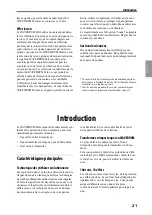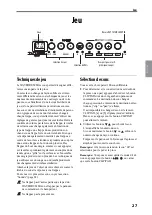
Performing
12
Using effects
Here's how to apply an effect to the sound. You can
use either effect 'a' or b', but not both.
• Press the FX button. Each time you press it, the
effect setting will cycle through effect 'a' (the 'a'
indicator lit), effect 'b' (the 'b' indicator lit), and
off (both indicators 'a' and 'b' unlit).
You won't be able to switch effects if the CLIP,
PAD, 'a', or 'b' indicators are blinking (Edit mode).
In this case, press the CLIP/PAD button to make the
indicator light up.
note:
You can assign different effect types to effects
'a' and 'b'. You can also adjust settings such as the
amount of effect that will be applied. For details on
these settings, refer to “Editing the settings” (See
page 14).
note:
Immediately after the power is turned on, the
effect will be off. 'a' and 'b' will remember the set-
tings that you had last specified before turning the
power off.
note:
You can also exit Edit mode by pressing the
, , or + buttons as well as the CLIP/PAD
button.
Playing and overdubbing
rhythm patterns
You can enjoy jamming along with rhythm patterns
in a variety of genres. You can also overdub your
own performance onto these rhythm patterns.
Playing back a rhythm pattern
1.
While holding down the SHIFT button, press the
button to make the rhythm pattern / looper
select indication (located in the upper right of the
operating panel) light up.
This selects the rhythm pattern function.
2.
Press the
button to start playback (the indi-
cator will light).
3.
Press the
button to stop playback (the indi-
cator will go dark).
4.
You can choose from 100 different rhythm pat-
terns. To switch rhythm patterns, press the + but-
ton. The next rhythm pattern (i.e., the pattern of
the following number) will be selected. If you
hold down the SHIFT button and press the + but-
ton, the previous rhythm pattern will be selected.
By holding down the + button, you can step
through the rhythm patterns.
The pattern number in the display will blink while
the rhythm pattern is switching. Once the change
has occurred, the display will revert to indicating
the sound number.
For details on each rhythm pattern, refer to
“Rhythm Patterns” (See page 69).
note:
You can adjust the volume of the rhythm pat-
tern. Refer to “Editing the settings” (See page 14).
note:
You can't change the playback speed of the
rhythm pattern.
Overdubbing your own performance onto a
rhythm pattern
1.
Select a rhythm pattern, and play it back. See
“Playing back a rhythm pattern.”
2.
Select the sound that you want to overdub. See
“Selecting sounds.”
3.
Press the button to start recording (the indica-
tor will light up).
4.
Strike the pad or the object where the clip is
attached; your performance will be recorded.
5.
Press the button or the
button to stop
recording.
If you press the
button, recording will end and
playback will continue. If you press the
but-
ton, recording will end and playback will stop.
6.
You can repeat the above steps to overdub your
performance as many times as you wish.
note:
If you want to erase your recorded perfor-
mance and re-record, you can use the Undo/Redo
function. Refer to “Undo and Redo” (See page 13).
note:
If you press the button from the stopped
condition, playback and recording will start simulta-
neously.
The recorded performance will disappear when
you select another rhythm pattern, switch to the
Looper function, or turn off the power. Imme-
diately after the power is turned on, the original
rhythm pattern 00 will be selected.
During playback and recording, the pad sensi-
tivity will automatically be lowered to prevent
acoustic feedback.
7.
You can mute (or unmute) the sound of the
rhythm pattern if desired. If you mute the rhythm
pattern, you'll hear only the performance that you
overdubbed.
Hold down the SHIFT button and press the FX
button. Each time you do so, muting will turn on/
Summary of Contents for Wavedrum mini
Page 2: ...2 ...
Page 51: ...Français English Voice Name ...

































